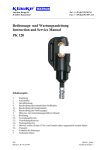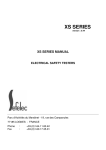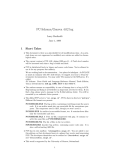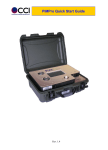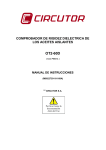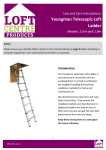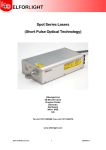Download user manual
Transcript
OPERATING MANUAL FOR THE 30KV A.C. TEST SET P123 Product: High Voltage AC Test Set Type: P123 Bicotest High Voltage Products Ltd Hellesdon Park Road, Drayton High Road, Norwich NR6 5DR United Kingdom Phone +44 1603 416 900 Fax +44 1603 416 902 [email protected] www.nisltd.co.uk HIGH VOLTAGE EQUIPMENT PLEASE READ CAREFULLY BEFORE OPERATING. SAFETY IS THE RESPOSIBILITY OF THE USER 1 GENERAL SAFETY STATEMENT The following safety precautions should be reviewed to avoid injury to the user and damage to the product (and other products connected to it). To avoid potential hazards only use this product as specified. • Only suitably qualified personnel should use this equipment. Servicing of this product should only be carried out by suitably qualified service personnel. • The high voltage generated by this unit is extremely dangerous and may be fatal. To Avoid Fire Hazards and Personal Injury • Use the correct power supply lead. Only use a suitably rated and approved power supply lead for the country of use. • Ensure that systems that the unit is to be connected to are dead. • Do not connect and disconnect leads whilst outputs are switched on. • Ensure that the product is grounded. To avoid electric shock it is essential that the grounding conductor is connected to the earth ground. Additional earth terminals are provided on the control unit and HV transformer that must be connected to a local earth. Ensure that the unit is properly grounded before making any connections to inputs or outputs. • Terminal ratings must be observed to prevent fire hazards and risk of injury to the operator. Consult the product manual for ratings information before making connections to any terminal. • It is ESSENTIAL to consult the product manual for rating information before making any connection to a terminal or terminal group marked with a warning triangle. • Only use fuses of a type and rating specified for this product. • Do not operate the unit out of its case or with any covers or panels removed. • Do not touch exposed connections and components when power is present. • Do not operate the product if any damage is suspected. Refer the unit to qualified service personnel to be checked. • Do not operate the unit in wet or damp conditions • Do not operate the unit in an explosive atmosphere If any further queries occur regarding the usage and maintenance of the equipment detailed in this manual, please refer these to the supplier of the equipment in the first case or to: Bicotest High Voltage Products Ltd 2 HIGH VOLTAGE SAFETY It is essential to follow safe working procedures when working with high voltage. Information on accepted codes of practice should be obtained from your local heath and safety regulatory body. IEEE standard 510-1983 (IEEE Recommended Practices for Safety in High-Voltage and HighPower Testing) provides a working framework for establishing safe procedures, but must be read in conjunction with local regulations and accepted codes of practice. The following excerpts are taken from IEEE 510 • All ungrounded terminals of the test equipment or apparatus under test should be considered as energised. • Common ground connections should be solidly connected to both the test set and the test specimen. As a minimum, the current capacity of the ground leads should exceed that necessary to carry the maximum possible ground current. The effect of ground potential rise due to the resistance and reactance of the earth connection should be considered. • Precautions should be taken to prevent accidental contact of live terminals by personnel, either by shielding the live terminals or by providing barriers around the area. • The circuit should include instrumentation for indicating the test voltages. • Appropriate switching and, where appropriate, an observer should be provided for the immediate de-energisation of test circuits for safety purposes. In the case of dc tests, provisions for discharging and grounding charged terminals and supporting insulation should also be included. • High-voltage and high-power tests should be performed and supervised by qualified personnel. • Consideration should be given to safety regulations which may apply to specific circumstances; for example, HSE, company, or government regulations. In the use of signal-gathering equipment, each device should be used in such a manner that it will not present a personnel hazard should it inadvertently become a part of the high-voltage circuit, or fail to function properly. 3 SAFETY TERMS AND SYMBOLS The following safety symbols appear on the equipment: CAUTION/WARNING – Refer to manual DANGER – High voltage Mains off Mains on The following safety symbols appear in this manual: CAUTION This action or procedure may be dangerous if not carried out correctly, and may cause damage to the equipment or connected equipment. WARNING This action or procedure may be cause injury or death to the operator or other personnel if not carried out correctly using applicable safety procedures. 4 CONTENTS 1. DESCRIPTION OF EQUIPMENT 6 1.1 Electrical Specification 6 1.1.1 Supply Requirements 6 1.1.2 Output Specifications 6 1.1.3 Zero Voltage Interlock: 6 1.2 Output Voltage Control 6 1.3 Overload Protection 7 1.3.1 Variable overload 7 1.4 Metering 7 1.5 Construction 7 2. OPERATION 8 2.1 Safety 8 2.1.1 Installation 8 2.1.2 Operation 8 2.2 Connections (See Figure 1) 10 2.3 Front Panel Control Functions 11 2.4 Method of Operation 13 3. MAINTENANCE 14 4. STANDARD ACCESSORIES 15 5. OVERALL PERFORMANCE SPECIFICATION 16 6. CALIBRATION RESULTS 17 5 1. DESCRIPTION OF EQUIPMENT 1.1 Electrical Specification 1.1.1 Supply Requirements The supply voltage will be as follows: 220/240V 1 phase 50/60Hz+10% 1200VA max 115V 1 phase 50/60Hz +10% -6% 1200VA max 1.1.2 Output Specifications The output voltage, current and duty cycle are as follows: Output Voltage P123 Output current Continuous 5 min on/15 min off 30kV 20mA 40mA One side of the high voltage transformer output is connected to the earth system of the equipment. 1.1.3 Zero Voltage Interlock: The equipment is fitted with a zero volt interlock system on the controlling regulator. This interlock prevents the output being energised unless the controlling regulator is in the minimum output position. 1.2 Output Voltage Control The output is controlled from zero by means of a regulating transformer. The transformer is operated by means of a control knob which is located on the front panel. To increase the output voltage the knob is turned in a clockwise direction. 6 1.3 Overload Protection The equipment is fitted with fixed and variable overload protection circuits as standard. 1.3.1 Variable overload The variable overload protection system senses current changes in the high voltage circuit. The trip level is adjusted by means of a selector switch on the front panel of the unit. The switch allows the level to be adjusted from 10-110% of normal full load current in eleven steps. The circuit will activate when the load current exceeds that set by the trip level selector switch. The circuit will respond to more slowly to changing levels of load current. IMPORTANT NOTE: The variable overload trip circuit does not limit the output current on short circuit. 1.4 Metering The equipment is provided with the following metering: 1.5 a. A moving coil dual range kilovoltmeter monitoring the output voltage from the equipment. b. A moving coil single range milliammeter monitoring the secondary current of the high voltage transformer. Construction The equipment is housed in a robust case with recessed carrying handles. All the controls and metering are located on the front panel together with all external connections. 7 2. OPERATION 2.1 Safety The output from the P123 is extremely dangerous, and if used incorrectly could be fatal. The unit must only be installed, operated, and maintained by suitably qualified and trained personnel. It is essential to follow accepted safety procedures and local health and safety regulations and guidelines when installing and operating high voltage equipment. A risk assessment should be undertaken on both the installation and the working procedures to ensure the safety of test personnel and all other personnel. 2.1.1 Installation 2.1.1.1 Test Area The unit must be installed in a suitable high voltage test area completely enclosed by walls or some type of physical barrier. Appropriate controls and safety measures must be applied to this area including interlocks connected to the supply or HV unit interlock to ensure that the unit cannot be switched on unless the area is secure. Refer to IEEE Std 510-1983 for further details of suitable test enclosures. The test area must also be identified with suitable signs. 2.1.1.2 Mains supply The unit must be connected to a suitable supply via an approved and suitably rated mains connector with earth connection. 2.1.1.3 Earthing Particular attention must be made in earthing the equipment, and all earth connections must be made with substantial conductors with secure joints. The earth connection on the unit must be connected to a suitable low impedance earth. The earth return from the test object must also be made with a suitable conductor back to the earth point on the unit. All earth connections must be able to withstand the largest fault current that may be encountered in the system. 2.1.2 Operation It is essential that safe working practices are maintained when conducting high voltage testing. Safe working procedures must be implemented to accepted standards. 8 2.1.2.1 Grounding of the high voltage output A temporary ground should be applied to the high voltage output when the circuit has been de-energised using the earth stick provided. When connections are made or disconnected, the circuit either side of the connection should be grounded first. Extra earth sticks are available from Bicotest High Voltage Products as an optional accessory. If the test circuit includes capacitors, each capacitor should be grounded separately before connections are made or broken. In the case of capacitors connected in series, the intermediate terminals should also be grounded. It is good practice for all capacitive devices to remain short-circuited when not in use. 2.1.2.2 High voltage connection The HV connection to the test object must be made securely, and suitable stress relief components should be used where required to keep electrical stresses within acceptable limits. 2.1.2.3 High voltage output clearances The high voltage output from the unit is from a screened cable with an un-screened termination, and adequate clearances must maintained between the following parts and any other conducting object (whether earthed or not): • HV output connection • Non-screened part of output cable • Non-grounded parts of test object Any part of the test object not connected to earth should be considered live at the test voltage. Particular attention should be paid to clearances between any parts of the test object at test voltage potential and the test enclosure or barriers. Refer to local safety standards for details of the clearances required. 9 2.2 Connections (See Figure 1) Before making any connections please ensure that you are aware of all hazards relating to the system and environment in which it is operating. The input lead on the control unit should be connected to a suitable three pin supply connector. Connect the earth lead from a reliable efficient earth to the earth terminal on the equipment. Connect the earth hook lead to the earth terminal on the test set and place the hook on the test object's high voltage terminal. IMPORTANT The output cable is only partially screened. it is therefore essential that the minimum clearance of 20cm be maintained around the unscreened portion of the output cable. To local earth screened part of HV cable screen limit and stress relief Supply cable unscreened part of HV cable Earth return Earth stick Test object Figure 1 Connection showing earthed test object – before start of test Note:-The test object is shown earthed via the earth stick as it should be between tests and before any adjustment to the test object. The earth stick should be removed from the test object before the test, and replaced after the test is complete. 10 2.3 Front Panel Control Functions A B P C N D M E L F K J H G Figure 2 Unit front panel 11 A Mains inlet connector B Earth terminal for connection to low impedance local earth C HV output D kV meter E kV meter range switch F mA meter divide by 10 switch G Output control knob H Key operated supply ON/OFF switch J HV output off switch – illuminated green when output is off K HV output on switch – illuminated red when output is on L Overcurrent trip reset switch M Overcurrent trip level control N mA meter P Mains supply fuse 12 2.4 Method of Operation Connect the equipment as described in Section 2.2. Remove the power switch operating key before connecting the equipment to the main supply. This will ensure the equipment is in the OFF position as the key is only removable in that position. The key is trapped in the ON position. Once the equipment is connected to the main supply the key operated switch can be moved to the ON position. The following will now occur: a. Power ON lamp will be lit b. HV OFF lamp will be lit c. The variable overload reset lamp will be lit Press the variable overload reset push-button thus arming the circuit. The indicator lamp in the reset push-button will go out thus indicating that the circuit is armed. Select the desired voltage range on the kV meter and set the desired overload mA trip level. Before commencing testing ensure that the regulator is in the fully anticlockwise position. Depress the HV ON push-button and this will close the internal circuit breaker The HV OFF lamp will extinguish and the HV ON lamp will be lit. The output voltage can now be increased to the desired level as indicated on the kV meter. In the event of a test object failure the HV output will be automatically switched off by the protection system. When the test is completed, turn the regulator control knob fully anti-clockwise and switch off the HV output and then the main supply. Before disconnecting the test object ensure the HV connection is grounded using the earthing stick provided. 13 3. MAINTENANCE The voltage regulator should be regularly examined, particularly in respect of the brushes, in order that the latter may be replaced before excessive wear has taken place. The intervals between inspection and renewal of the brushes will depend upon the mount of usage. However, it should be remembered that extensive damage to the voltage regulator can result if the brushes are allowed to wear away to such an extent that a loss of brush pressure occurs . The equipment's output cable should be kept clean and inspected regularly for damage. This applies especially to the unscreened portion of the output cable. 3.1 Removal of Unit from Case a. Remove all four M5 fixing screws from the underside of the set (centre of rubber feet). b. Place the set in the normal operating position, i.e. with the control panel horizontal and facing upwards. c. Remove all six panel fixing screws.(M6 posidrive screws, nylon washers) d. Remove the two M6 dome nuts from the lifting positions. e. Screw on to the exposed threads of the lifting positions the tommy bars provided. f. The set can now be lifted from the case taking care not to foul the supporting brackets. 14 4. STANDARD ACCESSORIES Spare fuses supplied a. 1 off T5A 1¼ inch b. 1 off F10A 1¼ inch The following items are provided with the equipment: a. Mains input lead. b. 2 keys (for mains ON/OFF switch). c. 5 metre earth lead fitted with clip and tag. d. Earthing stick. e. 2 tommy bars. f. Operating Manual. 15 5. OVERALL PERFORMANCE SPECIFICATION Insulation resistance at 1000V DC Not less than 10 megohms between mains input and frame. Applied voltage test 2kV RMS for 1 minute between mains input and frame Accuracy of instruments KV meter ±1.5% at full scale mA meter ±1.5% at full scale H V Transformer 2.5kV RMS for 1 minute between primary and earth 2.5kV RMS for 1 minute between earthy end of secondary and earth Complete Equipment Over voltage test Equipment run for 5 minutes at 115% of normal output voltage Flash over-test 6 flash-overs direct to ground at 100% of normal output voltage 16 6. CALIBRATION RESULTS Equipment Serial Number ............................................. P123 Range Unit meter Standard Unit meter Standard Unit meter 5 5 2 10 10 4 15 15 6 kV x1 20 8 25 10 30 2.5 2.5 1 5 5 2 7.5 7.5 3 kV x0.5 10 4 12.5 5 15 10 20 20 20 40 40 30 60 60 40 80 80 50 100 100 mA 120 17 Standard

















